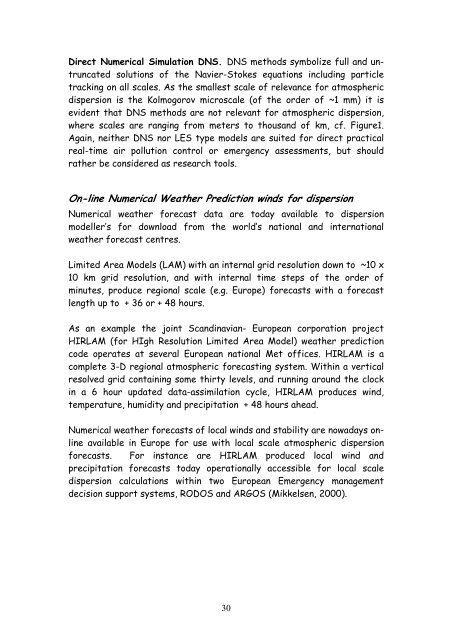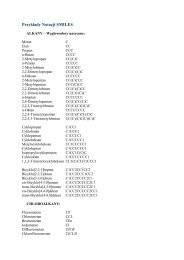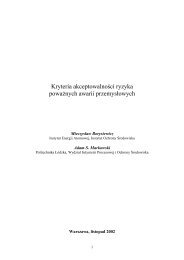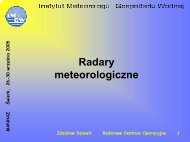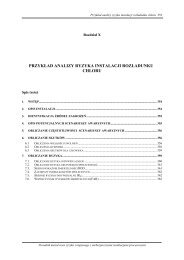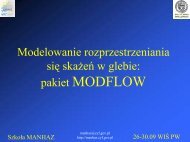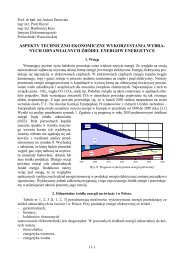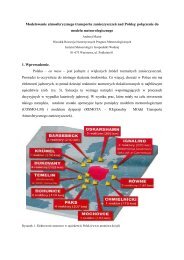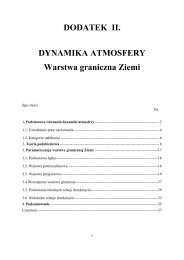Modelling of Pollutant Transport in the Atmosphere - MANHAZ
Modelling of Pollutant Transport in the Atmosphere - MANHAZ
Modelling of Pollutant Transport in the Atmosphere - MANHAZ
Create successful ePaper yourself
Turn your PDF publications into a flip-book with our unique Google optimized e-Paper software.
Direct Numerical Simulation DNS. DNS methods symbolize full and untruncated<br />
solutions <strong>of</strong> <strong>the</strong> Navier-Stokes equations <strong>in</strong>clud<strong>in</strong>g particle<br />
track<strong>in</strong>g on all scales. As <strong>the</strong> smallest scale <strong>of</strong> relevance for atmospheric<br />
dispersion is <strong>the</strong> Kolmogorov microscale (<strong>of</strong> <strong>the</strong> order <strong>of</strong> ~1 mm) it is<br />
evident that DNS methods are not relevant for atmospheric dispersion,<br />
where scales are rang<strong>in</strong>g from meters to thousand <strong>of</strong> km, cf. Figure1.<br />
Aga<strong>in</strong>, nei<strong>the</strong>r DNS nor LES type models are suited for direct practical<br />
real-time air pollution control or emergency assessments, but should<br />
ra<strong>the</strong>r be considered as research tools.<br />
On-l<strong>in</strong>e Numerical Wea<strong>the</strong>r Prediction w<strong>in</strong>ds for dispersion<br />
Numerical wea<strong>the</strong>r forecast data are today available to dispersion<br />
modeller’s for download from <strong>the</strong> world’s national and <strong>in</strong>ternational<br />
wea<strong>the</strong>r forecast centres.<br />
Limited Area Models (LAM) with an <strong>in</strong>ternal grid resolution down to ~10 x<br />
10 km grid resolution, and with <strong>in</strong>ternal time steps <strong>of</strong> <strong>the</strong> order <strong>of</strong><br />
m<strong>in</strong>utes, produce regional scale (e.g. Europe) forecasts with a forecast<br />
length up to + 36 or + 48 hours.<br />
As an example <strong>the</strong> jo<strong>in</strong>t Scand<strong>in</strong>avian- European corporation project<br />
HIRLAM (for HIgh Resolution Limited Area Model) wea<strong>the</strong>r prediction<br />
code operates at several European national Met <strong>of</strong>fices. HIRLAM is a<br />
complete 3-D regional atmospheric forecast<strong>in</strong>g system. With<strong>in</strong> a vertical<br />
resolved grid conta<strong>in</strong><strong>in</strong>g some thirty levels, and runn<strong>in</strong>g around <strong>the</strong> clock<br />
<strong>in</strong> a 6 hour updated data-assimilation cycle, HIRLAM produces w<strong>in</strong>d,<br />
temperature, humidity and precipitation + 48 hours ahead.<br />
Numerical wea<strong>the</strong>r forecasts <strong>of</strong> local w<strong>in</strong>ds and stability are nowadays onl<strong>in</strong>e<br />
available <strong>in</strong> Europe for use with local scale atmospheric dispersion<br />
forecasts. For <strong>in</strong>stance are HIRLAM produced local w<strong>in</strong>d and<br />
precipitation forecasts today operationally accessible for local scale<br />
dispersion calculations with<strong>in</strong> two European Emergency management<br />
decision support systems, RODOS and ARGOS (Mikkelsen, 2000).<br />
30


